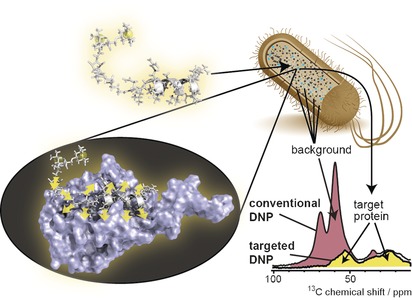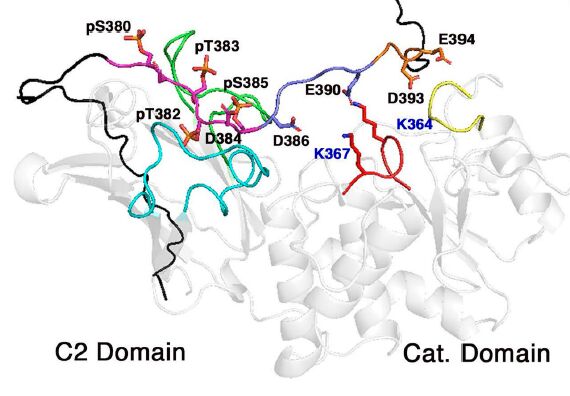Transcription factors are crucial for human gene expression and regulation. They contribute to determining why certain individuals live longer and have lower susceptibility to cancer, but in specific cases, they also play detrimental roles in disease progression and resistance. NMR is key tool in understanding transcriptions factors to their highly disordered nature.
Thibault Viennet, a recent member of the DANNMR community and assistant professor at Aarhus University, is founding a new research group to explore intriguing projects surrounding the role of transcription factors and other regulatory nodes in health and disease. As part of the Danish ultra-high field NMR center at Aarhus University, he aims to apply advanced NMR methods to comprehend these biological systems.
Originally from France, Thibault Viennet embarked on an academic journey that recently led him to Aarhus, Denmark, studying chemical engineering at Lille University in France, refining his skills in analytical techniques. His undergraduate years revealed that his true passion lays in research, diverting him away from a potential future in the industry.
Thibault’s academic focus shifted towards bio analytics, delving into the molecular intricacies of living organisms. During this period, he interned in the field of solid-state NMR, with a specific focus on viral capsids. This experience left an enduring impression, sparking his passion for NMR and research in this domain.
To deepen his exploration of NMR, Thibault relocated to Düsseldorf, Germany, specifically focusing on proteins with an emphasis on membrane proteins. However, his focus extended beyond studying biological specimens to include method development for both solution and solid-state NMR. Additionally, he ventured into the emerging field of Dynamic Nuclear Polarization (DNP).
Motivated by his fascination with biology and its potential to address questions related to disease and life, Thibault pursued a postdoctoral research opportunity in Boston, USA. Throughout a six-year employment, his research covered diverse areas, encompassing NMR method development and application. A central aspect of his postdoctoral work involved investigating protein regulation and phosphorylation. Thibault’s team explored kinases and phosphatases, key players in cellular signaling, along with collaborative projects examining methyltransferases and their regulatory mechanisms. Recently, he has been delving into the investigation of transcription factors.
“Transcription factors are intriguing, especially due to their high degree of disorder and complexity in regulation. They play a central role in understanding gene expression and regulation, involving numerous modification sites and interactions.” Thibault explains.
Thibault has initiated a project focused on a crucial transcription factor for maintaining cellular metabolism. It acts as a tumor suppressor, reducing the risk of cancer and contributing to longevity, fascinating geneticists studying aging populations.
Group Size and Collaboration
Thibault is currently in the process of setting up his research group and laboratory. Currently, his group comprises only himself, but he is actively working on securing funding, equipping the lab, and recruiting students, postdoctoral researchers, and additional personnel. With the expectation of expansion in the next six months, Thibault anticipates the emergence of a fully-fledged research group, therefore he is eager to get to know the various research groups across Denmark, building collaborations and gaining insights from these groups essential for his own group’s development and success.
Thibault sees the research landscape in Aarhus as very complementary to his expertise. He brings advanced solution NMR methods and applications for studying biological systems, while Aarhus provides him with a strong theoretical and methodological background that can help create tailored methods for specific systems. The potential for this collaboration is one of the key strengths of his move to Aarhus.
“Within the NMR community in Aarhus, while the groups are relatively small, there is a sense of community and collaboration.” Thibault tells.
Thibault has interacted primarily with researchers such as Niels Christian Nielsen and Thomas Vosegaard, whose work aligns closely with his research objectives. He also sees the potential for strong collaborations with the molecular biology department at Aarhus, fostering a network of diverse research interests and opportunities.
Unique NMR Methods
Thibault’s research contributions in NMR include the development of innovative and unconventional techniques. During his doctoral studies, he explored the challenging task of studying biomolecules in their native state using NMR, a feat not easy to achieve with other methods. His work involved in-cell NMR and native-state NMR, where he developed a groundbreaking approach called “targeted DNP” (Dynamic Nuclear Polarization). This technique utilizes DNP to selectively amplify signals from target proteins, creating hyperpolarization and offering critical insights. Although “targeted DNP” had limitations associated with DNP, it eliminated the need for recombinant expression in non-natural systems, which was a significant achievement in NMR research.
In his postdoctoral research, Thibault specialized in tailored solution NMR methods for disordered proteins. His work made use of a special NMR probe optimized for direct nitrogen detection, addressing challenges associated with the behavior of disordered proteins in solution.
Leveraging the 13C-15N dimensional space (rather than 15N-1H) resulted in enhanced dispersion and massively improved resolution. Furthermore, Thibault developed optimal control pulses designed for specific applications, enabling the assignment of complex and challenging proteins. These advancements provided crucial structural information, even in situations where conventional NMR techniques fall short.


Cancer Research
Thibault’s time at the Dana-Farber Cancer Institute in Boston exposed him to a scientific community with a strong focus on cancer research.
“When you work on a human protein, you can always find a link to cancer, but [there] we had to always really think about cancer when designing our research.” He emphazises.
Collaborations with experts in cell biology and clinical medicine played an important role in his work at Dana Farber. Notably, he collaborated with the lab of Philip Cole, a prominent figure in chemical biology, on investigations into the complex mechanisms governing kinases and phosphatases, which are among the topmost frequently mutated genes in various forms of cancer and are critically important in cancer development.
Thibault’s work emphasized the need to understand the regulation of these genes, especially in the context of cancer, as structural biology alone couldn’t provide a complete understanding of complex diseases.
Collaborations
Thibault places a strong emphasis on collaboration in his research philosophy, especially as he establishes his research group. His experience in the global NMR community has taught him the value of collaboration and the importance of leveraging existing knowledge and expertise.
“I have a few collaborations in Aarhus and I’m quite excited to meet more people in Denmark. I’ve been in the general NMR Community for a little while now, so I know some people, and I think it’s important for a new group to not try and re-invent the wheel and take the help you can get.” Thibault says of his new group.
Collaborations extend not only to NMR method development but also to biology. He recognizes the synergy between atomic-level understanding and a broader perspective on biological processes and how they complement each other. This collaboration, he believes, is essential for making groundbreaking discoveries, and he emphasizes the importance of having different points of view on the same problems.
Future Projects
In Aarhus, Thibault’s primary focus is on studying transcription factors, particularly due to their high degree of disorder and complexity in regulation. Transcription factors are central to understanding gene expression and regulation, with numerous modification sites and interactions.
Particularly, Thibault is currently trying to secure funding to explore a class of transcription factors that act as tumor suppressors. Despite their generally positive effects, they can also become a problem, as they have been shown to protect cancer cells from drugs, thereby promoting cancer resistance.
Understanding their mechanisms of regulation is a significant scientific challenge and holds promise for unraveling their intricate functions as protectors and adversaries in the context of cancer and other diseases.
Strength of Danish NMR
“There’s a decent-sized community with pretty good equipment, especially considering the size of the country. While the equipment isn’t as top notch as in other countries, it’s still sufficient to perform leading research in NMR. The strength of this community lies in its size—it’s large enough for regular meetings. We all come together once a year, which is a far cry from the overwhelming numbers you’d find in France or Germany. There, it’s impossible for everyone to convene, even at the larger conferences. This size allows you to get to know everyone, their strengths, and exactly what they specialize in. You know who to approach if you have specific questions, need a particular tool, or want to explore collaborations.” Thibault explains.
“The diversity in research backgrounds and interests is a real asset. Some researchers are deeply engrossed in biology, while others focus on material sciences, food sciences, method development, hyperpolarization, and more. It seems like a vibrant community.” Thibault ends.
Written by: Jonatan Emil Svendsen


Really superb info can be found on blog.Raise blog range